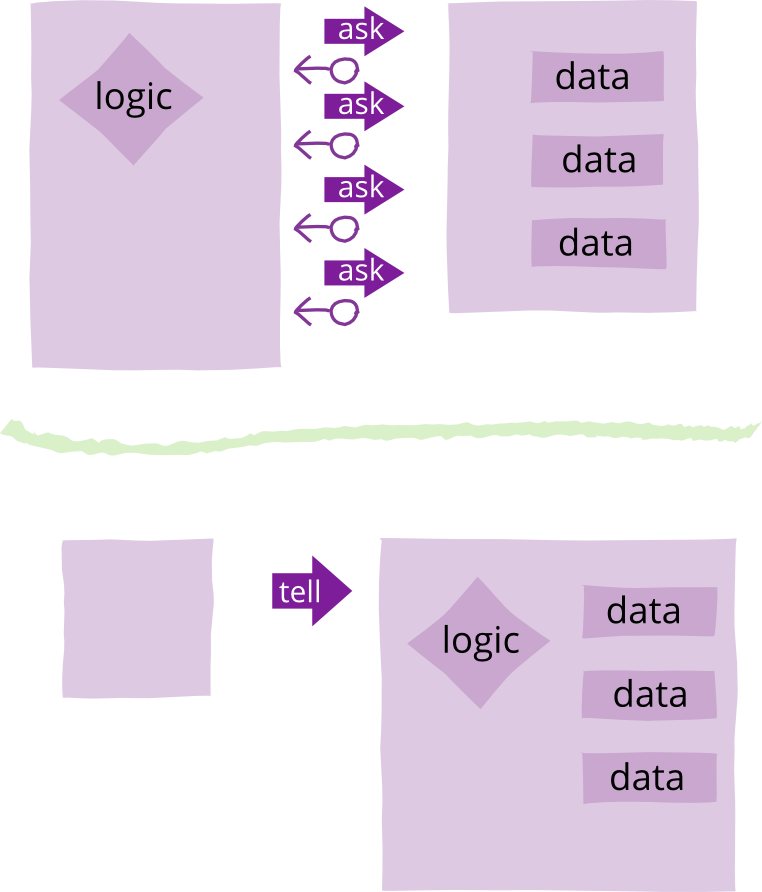3.11. ADR Dragon Damage Take¶
Make 10 points damage to the dragon
Make 20 points damage to the dragon
Make 30 points damage to the dragon
Make 40 points damage to the dragon
Make 50 points damage to the dragon
3.11.1. Option 1¶
>>> dragon.set_damage(DMG)
Pros and Cons:
Good: easy to use
Good: clear intent
Good: encapsulation
Bad: the name indicates a setter of a
damageattributeBad: not Pythonic way
Decision: rejected, method name indicates something else
3.11.2. Option 2¶
>>> dragon.set_health(DMG)
Pros and Cons:
Good: easy to use
Good: clear intent
Good: encapsulation
Bad: the name indicates a setter of a
healthattributeBad: not Pythonic way
Decision: rejected, telldontask
Problem:
>>> dmg = hero.make_damage()
>>> result = dragon.health - dmg
>>>
>>> dragon.change_health(result)
Use Case:
>>> file.change_content('hello world')

3.11.3. Option 3¶
>>> dragon.change_health(-10)
>>> dragon.change_health(-20)
>>> dragon.change_health(-30)
>>> dragon.change_health(-40)
>>> dragon.change_health(-50)
Pros and Cons:
Good: easy to use
Good: clear intent
Good: encapsulation
Bad: the name indicates a setter of a
healthattributeBad: abstraction
Bad: not Pythonic way
Decision: rejected, method name indicates something else
3.11.4. Option 4¶
>>> dragon.wound(DMG) # dragon -> enemy
>>> dragon.hurt(DMG) # dragon <- enemy
>>> dragon.hit(DMG) # dragon <-> enemy
>>> dragon.damage(DMG) # dragon -> enemy
Pros and Cons:
Bad: Indication of direction is too weak
dragon <-> enemyDecision: rejected, indication of direction is too weak
Example:
>>> dragon.hit(10) # bad, dragon make or take 10 damage?
Rationale:
dragon --> enemy
dragon -> enemy
dragon <-> enemy
dragon <- enemy
dragon <-- enemy
3.11.5. Option 5¶
>>> dragon.hurt_self(DMG)
>>> dragon.hurt_me(DMG)
>>> dragon.receive_damage(DMG)
>>> dragon.suffer_damage(DMG)
Pros and Cons:
Good: Explicit relation
dragon --> enemyGood: Consistent with
deal_damage()Bad:
hurt_self()is too use-case specificBad: Inconsistent with
make_damage()Decision: rejected, method names are too use-case specific
Example:
>>> dragon.hurt_self(DMG)
>>> chair.hurt_self(DMG)
>>> barrel.hurt_self(DMG)
>>> dragon.receive_damage(DMG)
>>> chair.receive_damage(DMG)
>>> barrel.receive_damage(DMG)
3.11.6. Option 6¶
>>> dragon.take_damage(DMG)
Pros and Cons:
Good: Explicit relation
dragon --> enemyGood: Consistent with
make_damage()Decision: candidate
Example:
>>> dragon.take_damage(DMG)
>>> chair.take_damage(DMG)
>>> barrel.take_damage(DMG)
3.11.7. Option 7¶
>>> dragon.health - DMG
>>> dragon.health -= DMG
Pros and Cons:
Good: simple
Good: can use
@propertyfor validation if neededBad: requires knowledge of API
Bad: violates encapsulation
Decision: rejected, violates encapsulation
3.11.8. Option 8¶
>>> dragon.health - Damage(20)
>>> dragon.health -= Damage(20)
Pros and Cons:
Good: simple
Good: can use
@propertyfor validation if neededBad: requires knowledge of API
Bad: violates encapsulation
Decision: rejected, violates encapsulation
3.11.9. Option 9¶
>>> dragon - DMG
>>> dragon -= DMG
Pros and Cons:
Good: simple
Good: can use
.__sub__()for validation if neededBad: requires knowledge of API
Decision: rejected, not explicit and requires knowledge of API
3.11.10. Option 10¶
>>> dragon - Damage(20)
>>> dragon -= Damage(20)
Pros and Cons:
Good: simple
Good: can use
.__sub__()for validation if neededBad: requires knowledge of API
Decision: rejected, not explicit and requires knowledge of API
3.11.11. Option 11¶
>>> dragon < Damage(20)
>>> dragon <= Damage(20)
>>> dragon << Damage(20)
Pros and Cons:
Good: simple
Good: can use
.__lt__(),.__le__()for validation if neededBad: requires knowledge of API
Decision: rejected, not explicit and requires knowledge of API
3.11.12. Decision¶
>>> dragon.take_damage(DMG)
Pros and Cons:
Good: provides encapsulation
Good: easy to use
Good: explicit relation
dragon --> enemy
Implementation:
>>> class Dragon:
... def take_damage(damage: int, /) -> None: ...